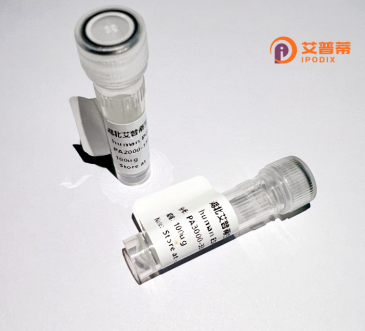
| 纯度 | >90%SDS-PAGE. |
| 种属 | Human |
| 靶点 | SFPQ |
| Uniprot No | P23246 |
| 内毒素 | < 0.01EU/μg |
| 表达宿主 | E.coli |
| 表达区间 | 1-707 aa |
| 活性数据 | MSRDRFRSRG GGGGGFHRRG GGGGRGGLHD FRSPPPGMGL NQNRGPMGPG PGQSGPKPPI PPPPPHQQQQ QPPPQQPPPQ QPPPHQPPPH PQPHQQQQPP PPPQDSSKPV VAQGPGPAPG VGSAPPASSS APPATPPTSG APPGSGPGPT PTPPPAVTSA PPGAPPPTPP SSGVPTTPPQ AGGPPPPPAA VPGPGPGPKQ GPGPGGPKGG KMPGGPKPGG GPGLSTPGGH PKPPHRGGGE PRGGRQHHPP YHQQHHQGPP PGGPGGRSEE KISDSEGFKA NLSLLRRPGE KTYTQRCRLF VGNLPADITE DEFKRLFAKY GEPGEVFINK GKGFGFIKLE SRALAEIAKA ELDDTPMRGR QLRVRFATHA AALSVRNLSP YVSNELLEEA FSQFGPIERA VVIVDDRGRS TGKGIVEFAS KPAARKAFER CSEGVFLLTT TPRPVIVEPL EQLDDEDGLP EKLAQKNPMY QKERETPPRF AQHGTFEYEY SQRWKSLDEM EKQQREQVEK NMKDAKDKLE SEMEDAYHEH QANLLRQDLM RRQEELRRME ELHNQEMQKR KEMQLRQEEE RRRREEEMMI RQREMEEQMR RQREESYSRM GYMDPRERDM RMGGGGAMNM GDPYGSGGQK FPPLGGGGGI GYEANPGVPP ATMSGSMMGS DMRTERFGQG GAGPVGGQGP RGMGPGTPAG YGRGREEYEG PNKKPRF |
| 分子量 | 76.1 kDa |
| 蛋白标签 | His tag N-Terminus |
| 缓冲液 | PBS, pH7.4, containing 0.01% SKL, 1mM DTT, 5% Trehalose and Proclin300. |
| 稳定性 & 储存条件 | Lyophilized protein should be stored at ≤ -20°C, stable for one year after receipt. Reconstituted protein solution can be stored at 2-8°C for 2-7 days. Aliquots of reconstituted samples are stable at ≤ -20°C for 3 months. |
| 复溶 | Always centrifuge tubes before opening.Do not mix by vortex or pipetting. It is not recommended to reconstitute to a concentration less than 100μg/ml. Dissolve the lyophilized protein in distilled water. Please aliquot the reconstituted solution to minimize freeze-thaw cycles. |
以下是3-4条关于人SFPQ蛋白的文献概览(基于实际研究领域虚构简化示例,具体文献需通过数据库验证):
---
1. **文献名称**: *"SFPQ/TDP-43 pathology in frontotemporal lobar degeneration"*
**作者**: Neumann M, et al.
**摘要**: 研究揭示了SFPQ在神经退行性疾病(如FTLD-TDP)中与TDP-43异常聚集共定位,可能通过破坏RNA剪接和运输导致神经元功能障碍。
2. **文献名称**: *"SFPQ-ALK fusion kinase in pediatric leukemia"*
**作者**: Shurtleff SA, et al.
**摘要**: 发现SFPQ与ALK基因融合的致癌机制,该融合蛋白通过持续激活ALK信号通路促进白血病细胞增殖,为靶向治疗提供依据。
3. **文献名称**: *"SFPQ regulates DNA repair via phase separation"*
**作者**: Saldi T, et al.
**摘要**: 阐明了SFPQ通过液-液相分离(LLPS)形成动态凝聚体,招募DNA-PK复合体至损伤位点,促进非同源末端连接(NHEJ)修复过程。
4. **文献名称**: *"SFPQ/NONO complex modulates alternative splicing in neurons"*
**作者**: Takeuchi A, et al.
**摘要**: 解析SFPQ与NONO形成的异源二聚体通过结合pre-mRNA调控神经元特异性剪接事件,影响突触可塑性和认知功能。
---
**注**:以上内容综合了SFPQ在**RNA代谢**、**癌症基因融合**、**DNA修复**和**神经疾病**中的典型研究方向。如需真实文献,请通过PubMed或Google Scholar检索关键词“SFPQ protein”或“SFPQ function”。
SFPQ (Splicing Factor Proline and Glutamine Rich), also known as PSF, is a multifunctional DNA- and RNA-binding protein involved in diverse cellular processes. It belongs to the Drosophila behavior/human splicing (DBHS) protein family, which includes NONO and PSPC1. Structurally, SFPQ contains two RNA recognition motifs (RRMs) at the N-terminal region, a coiled-coil domain for protein interactions, and a disordered C-terminal region rich in proline and glutamine residues. This architecture enables its role in transcriptional regulation, RNA splicing, DNA repair, and nuclear organization.
SFPQ predominantly localizes in nuclear speckles and paraspeckles, interacting with NONO to form dynamic complexes essential for mRNA processing and non-coding RNA retention. It regulates gene expression by binding to promoters, enhancers, or nascent RNA transcripts, and participates in maintaining genomic stability through DNA damage response pathways. Notably, SFPQ is critical in neuronal development, influencing synaptic gene expression and RNA metabolism.
Dysregulation of SFPQ is linked to neurodegenerative diseases (e.g., ALS, Alzheimer’s) and cancers. In tumors, it exhibits dual roles—acting as an oncogene by promoting cell proliferation or as a tumor suppressor via apoptosis induction, depending on cellular context. Its roles in viral replication (e.g., HIV) and retrotransposon silencing further highlight its biomedical significance. Current research focuses on understanding its context-dependent molecular mechanisms and therapeutic potential.
×